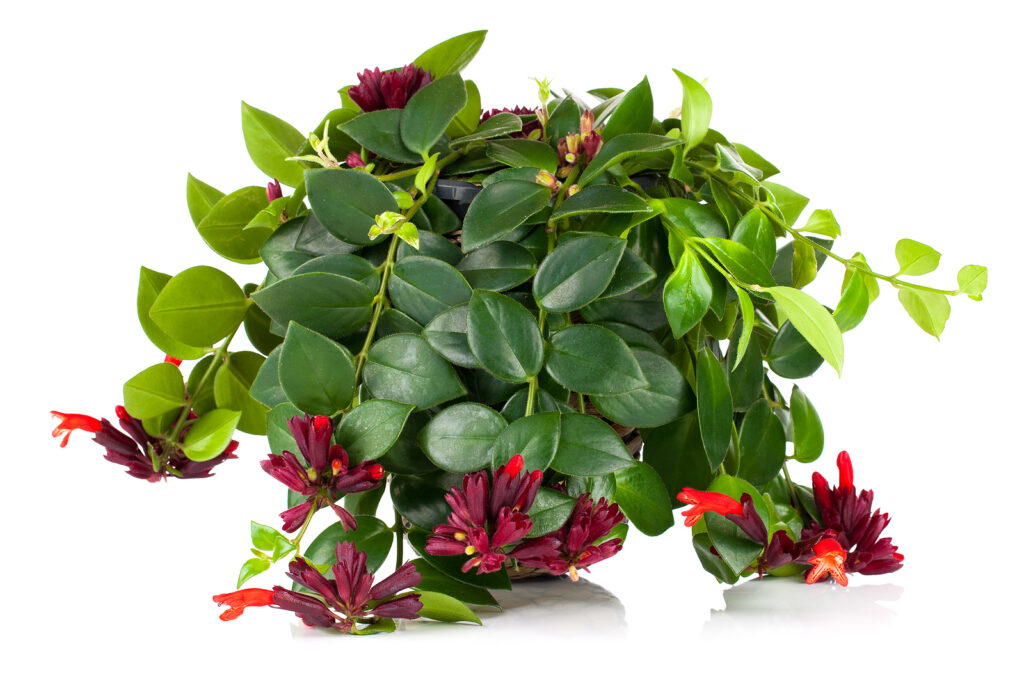Aeschynanthus is generally a carefree plant when given the right growing conditions. It has long drooping or trailing stems, shiny leaves, and dramatic tubular flowers. The main blooming season begins in summer but flowers may appear sporadically throughout the year.
Aeschynanthus is commonly called lipstick plant, basket plant, or basket vine.
Aeschynanthus stems grow from 8 to 24 inches (20-60cm) long or more. The leaves are oval, green, and leathery. They grow along the stem in pairs or whorls.
Aeschynanthus looks best in hanging baskets or set atop a pedestal. It is commonly grown as a houseplant but can be planted outdoors in tropical and subtropical climates.
Aeschynanthus is a genus of about 140 species of evergreen subshrubs and climbers native to subtropical forests in the Himalayas, South China, Malaysia, and Indonesia.
Get to know Aeschynanthus
- Plant type: Tropical vining, trailing perennial
- Growing Zones and range: Zones 14-15
- Hardiness: Tender
- Optimal growing temperature: day at least 75℉ (24℃), night 60℉ (16℃.
- Height and width: 24 inches (60m) tall and wide; stems trail to 3 feet (76cm) long
- Foliage: Oval green leathery leaves with lighter green veins; undersides of leaves are flushed with maroon; leaves grow in pairs or in whorls
- Flowers: Tubular red 2-inch flowers that have yellow throats
- Bloom time: Summer; may bloom sporadically throughout the year
- Uses: Hanging baskets
- Common name: Lipstick plant, basket plant, climbing beauty, pipe plant
- Botanical name: Aeschynanthus
- Family: Gesneriaceae
- Origin: Subtropical forests in the Himalayas, South China, Malaysia, and Indonesia

Where to plant Aeschynanthus
- Light outdoors: Grow Aeschynanthus in partial shade outdoors; they will tolerate a more sunny position if the humidity is high.
- Light indoors: Give Aeschynanthus bright reflected light (not direct sun), warm room temperature, and medium humidity
- Soil outdoors: Grow in humus-rich, well-drained soil.
- Soil indoors: Pot Aeschynanthus in a peat-based soilless mix. Repot every two years.
When to plant Aeschynanthus
- Set Aeschynanthus outdoors only in subtropical regions; set plants out any time of the year.
Planting and spacing Aeschynanthus
- Space Aeschynanthus plants 24 inches (60cm) apart.
How to water and feed Aeschynanthus
- Keep the potting mix evenly moist but not soggy. Keep humidity high by frequent misting—or grow in a naturally humid room such as a kitchen or bathroom. The optimal humidity is 70 percent.
- Apply fertilizer regularly throughout the year.
Aeschynanthus care
- After flowering, prune stems back by about one-third to encourage new growth and a full appearance.
- Aeschynanthus has no dormant period. Given generous amounts of light and brief alternating periods of moisture and dryness, it can bloom year-round. Most species bloom in spring and fall.
Growing Aeschyanthus as a houseplant
- Give Aeschyanthus bright light, warm room temperature, and medium humidity.
- Keep the potting mix evenly moist but not soggy.
- Apply fertilizers regularly throughout the year.
Aeschynanthus pests and diseases
- Aeschynanthus is susceptible to damage by aphids and mealybugs.
Aeschynanthus propagation
- Propagate Aeschynanthus by a simple layering of or from stem cuttings in spring or by seed.
Aeschynanthus varieties to grow
- Aeschynanthus lobbianus is called lipstick vine; it has cream-throated red flowers arising from brown ‘lipstick’ cases.
- A. longiflorus produces masses of deep red flowers.
- A. marmoratus, commonly known as the zebra basket; vine trails to 2 feet (61cm) in length; foliage is green mottled with maroon; it has yellowish flowers.
- A. x hybridus ‘Black Pagoda’ grows in a trailing form and has leaves longer than A. marmoratus
- A. pulcher produces scarlet flowers with yellow throats and waxy leaves that are light green.
- A. radicans is called lipstick plant because of the way its flowers emerge from their calyxes—like lipstick from a case. Drooping stems and 2-inch-long tubular flowers.
- A. speciosus has a growth habit similar to others but bears yellow-and-orange flowers up to 4 inches long.
Aeschynanthus frequently asked questions
Q: What temperature does lipstick plant want?
A: Aeschynanthus wants average or above-average warmth in summer. The plant should be kept fairly cool in winter with a minimum temperature of 55℉.
Q: How should I water and feed Aeschynanthus–lipstick plant?
A: Water the lipstick plant freely from spring to autumn and sparingly in winter. Use tepid water. Mist the leaves frequently, especially in hot weather. Fertilize monthly in spring and summer.
Q: How can I get Aeschynanthus–lipstick plant–to bloom?
A: Aeschynanthus may not bloom under ordinary room conditions. It can flower profusely one year and not at all the following year. Requirements for flowering are humid air in summer and a period of rest in winter, with a temperature range of 55℉ to 65℉. When the flowering time is over, cut back the stems by 6 inches, especially if growth is straggly; this will encourage new growth. Keep the plant in a well lit place in winter.



